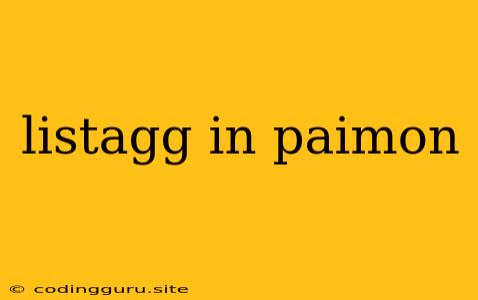Listagg: A Powerful Tool for Concatenating Strings in Paimon
Paimon, a powerful and versatile database management system, offers a plethora of functions and tools to manipulate data effectively. One such function, listagg, proves invaluable when it comes to concatenating multiple strings into a single, cohesive string. This function is particularly useful for generating reports, creating summaries, or simply combining data for a more user-friendly presentation.
Understanding Listagg: A Simple Analogy
Imagine you have a list of ingredients for a delicious cake: flour, sugar, eggs, butter, and vanilla extract. To create the recipe, you need to combine these ingredients into a single string. listagg works like a culinary chef, meticulously combining these ingredients (strings) in a specific order, separated by a delimiter of your choice.
The Syntax of Listagg in Paimon
The basic syntax of the listagg function in Paimon follows this format:
LISTAGG(expression, delimiter) WITHIN GROUP (ORDER BY sort_expression)
Let's break down this syntax:
expression: This represents the column or expression containing the strings you want to concatenate.delimiter: This specifies the character or string that separates the concatenated strings. You can use spaces, commas, hyphens, or any other character you prefer.WITHIN GROUP (ORDER BY sort_expression): This optional clause allows you to sort the concatenated strings based on a specified column or expression (sort_expression).
Practical Examples: Making Listagg Work for You
Scenario 1: Combining Product Names
Let's say you have a table named Products with columns Product_ID and Product_Name. To combine all product names into a single string separated by commas, you can use the following query:
SELECT LISTAGG(Product_Name, ', ') WITHIN GROUP (ORDER BY Product_Name) AS Combined_Product_Names
FROM Products;
Scenario 2: Creating a Summary of Customer Orders
Consider a table named Orders with columns Order_ID and Customer_Name. To generate a summary of customer orders, you can utilize listagg like this:
SELECT Customer_Name, LISTAGG(Order_ID, ', ') WITHIN GROUP (ORDER BY Order_ID) AS Order_Summary
FROM Orders
GROUP BY Customer_Name;
Scenario 3: Concatenating Employee Skills
Let's assume you have a table called Employees with columns Employee_ID and Skill. To combine all employee skills into a comma-separated string, you can use:
SELECT Employee_ID, LISTAGG(Skill, ', ') WITHIN GROUP (ORDER BY Skill) AS Employee_Skills
FROM Employees
GROUP BY Employee_ID;
Tips and Tricks for Effective Listagg Usage
- Delimiters: Choose a delimiter that enhances readability and makes your concatenated string easy to parse.
- Order by: Utilize the
ORDER BYclause to arrange your concatenated strings logically. - Group by: When combining strings from different rows, remember to use the
GROUP BYclause to ensure accurate aggregation.
Limitations of Listagg
While listagg is incredibly powerful, it does have limitations:
- Length Restriction: Paimon imposes a maximum length for the concatenated string. If your string exceeds this limit, it will be truncated.
- Performance Considerations: Using
listaggon large datasets can impact query performance.
Conclusion
listagg is a valuable function in Paimon that allows you to concatenate strings efficiently and effectively. By understanding its syntax and nuances, you can leverage this function to generate reports, create summaries, and improve the presentation of your data in various scenarios.
